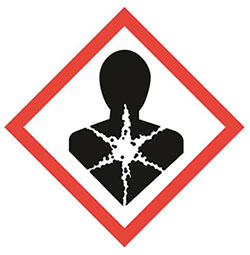

Working conditions
Reprotoxic substances
Reprotoxic substances are chemical substances which are harmful to reproduction and can cause adverse non-hereditary effects on the offspring or increase the occurrence of such effects through inhalation, ingestion or skin contact.
Exposure to certain chemical substances can harm the production of sperm cells in testicles, which could potentially lead to infertility. As for women, there is a potential connection between exposure to organic solvents and miscarriages. Toxic substances can result in the death of the embryo or fetus, cause structural abnormalities (teratogenicity), harm the development of the fetus or cause functional disorders for the offspring, including breastfed children.
The following substances are reproductive toxins:
- bisphenol A (BPA)
- certain phthalates, such as di(2-ethylhexyl) phthalate (DEHP) and dibutyl phthalate (DBP)
- reprotoxic metals, such as lead and mercury compounds
- organic solvents, such as 2-ethoxyethanol
- naphtha and trichloroethylene
- pesticides
- carbon monoxide
- inhalational anaesthetic agents, such as nitrous oxide
- cytostatic drugs.
Reprotoxic substances: classification and labelling
Reprotoxic substances and mixtures can be identified by the fact that they are classified as category 1A or 1B reproductive toxins under the Classification, Labelling and Packaging (CLP) Regulation. These substances and mixtures are also labelled with a hazard statement (H) and a hazard pictogram:
| CLP Regulation H360 May impair fertility or cause harm to the unborn child Danger |
|
Substances and mixtures suspected of impairing fertility or causing damage to the fetus are classified as category 2 under the CLP Regulation. They are also labelled with a hazard statement (H) and a hazard pictogram:
| CLP Regulation H361 Suspected of damaging fertility or the unborn child Warning |
 |
Reprotoxic substances
The following factors pose a risk to reproductive health at work:
- chemical substances, mixtures and compounds belonging to one or more of the following hazard groups or categories and to which one or more of the following hazard statements apply:
- germ cell mutagenicity, category 1A, 1B or 2 (H340, H341)
- carcinogenicity, category 1A, 1B or 2 (H350, H350i, H351)
- reproductive toxicity, category 1A, 1B or 2 or additional category “effects on or via lactation” (H360, H360D, H360F, H360FD, H360Fd, H360Df, H361, H361d, H361f, H361fd, H362)
- specific target organ toxicity, single exposure, category 1 or 2 (H370, H371)
- other chemical agents, see below:
- inhalational anaesthetic agents
- mercury and mercury compounds
- carbon monoxide
- organic solvents
- cytostatic drugs
- synthetic oestrogens and progestins.
Reproductive health hazards also include different hazardous biological agents and physical factors. Read more about these factors on pages Biological agents and Physical factors.
Employer’s responsibilities
It is the employer’s duty to ensure that factors and agents posing a risk to reproductive health are replaced with less hazardous ones when it is technically and reasonably possible. Further information on managing hazardous substances is available on the page Risk of cancer.
It is the employer’s duty to notify employees if the work involves factors that could pose a risk to the pregnancy or the development of the fetus. In these types of tasks, pregnant employees must notify their employer or occupational health care services of their pregnancy.
The employer must ensure that pregnant employees are not using methods or being exposed to chemical agents which can be reasonably considered a risk to the pregnancy or the development of the fetus. If hazard elimination is not possible, the employee should be assigned to other suitable duties until the start of parental leave, taking the employee’s professional skills and experience into consideration.
Special maternity leave
If a pregnant woman cannot be assigned to other duties but is still capable of work, she is entitled to special maternity allowance. Special maternity allowance and special maternity leave may be granted from the beginning of the pregnancy and continued until the beginning of maternity leave. Provisions regarding special maternity allowance are laid down in the Employment Contracts Act (55/2001) and in the Health Insurance Act (1224/2004). Special maternity allowance applications are submitted to Kela, the Social Insurance Institution of Finland.
Required attachments include a medical certificate from the employer’s occupational health physician stating the tasks and exposures deemed harmful to pregnancy or fetal development. Another required attachment is a statement from the employer proving that the pregnant employee cannot be assigned to other duties which would be safe for fetal development and pregnancy.
Further information:
Tyosuojelu.fi: Maternity, paternity or parental leave
Finnish Institute of Occupational Health: Special maternity leave and allowance (in Finnish)

